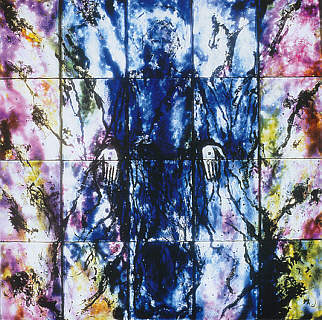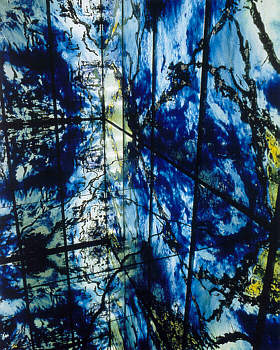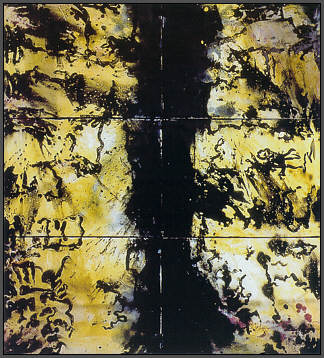|
Tróndur Patursson |
|
|
Today, the Faeroese artist Tróndur Patursson is well known both as a painter and as a sculptor. Above all, he is widely known for his glass paintings and his mirror/glass-installations. He was born in 1944 in the village of Kirkjubøur, on the island of Streymoy, where he sill resides. Patursson’s artistic training was acquired chiefly at the Kunsthåndværkerskolen [School of Art and Design] in Voss, near Bergen, and partly at the Art Academy in Oslo. Tróndur Patursson occupies a prominent position in the developmental history of Faeroese art as one of the driving forces behind the long overdue process of renewal initiated by Ingálvur av Reyni (born in 1920), which attained its real breakthrough in the work of the succeeding generation of artists born in the 1940s. Before Ingálvur av Reyni, Faeroese art was conjoined with a rather conspicuous conservatism in the adherence to a purely figurative interpretation of nature. The Faeroese artists’ motive of choice, for obvious reasons, was the rugged and imposing landscape surrounding them: the ocean, the rocky cliffs and the settlements, depicted under the 24-hour cycle’s and the seasons’ different kinds of weather and varying light conditions. One generation after the next, the Faeroe islanders remained steadfast naturalists, who turned the everlastingly favorite motive – the settlement by the sea – into a national archetype which, by and by, threatened to wind up imminently in sheer trivialization. It was not until the last third of the twentieth century that the foundations beneath this conservative landscape tradition began to sway – with Reyni as the great pioneer of the new departure. Even so, until around 1960, he was a relatively "well-behaved" interpreter of Faeroese nature. From the start of the 1960s, however, the non-figurative continued to gain an increasingly stronger foothold in Reyni’s art. In the course of the 1970s, the artist’s portraiture of nature, so bound up with tradition, was abandoned entirely and replaced with an expressive abstraction, delivered through a coloring which could certainly be called ‘inspired by nature’, but is absolutely not an imitation of nature.
Tróndur Patursson is one of those artists in the generation after Reyni who has been particularly attentive to the new expressive possibilities inherent in the abstract. Patursson is a painter. But to a certain extent, he is also a sculptor. And he often amalgamates these two disciplines in his works: for example, in his birds and whales made of glass and in his large glass/mirror-room-installations. He has always worked boldly, in an experimental and barrier-breaking way, in both painting and sculpture. As a sculptor, he is the only one of his generation who has assiduously been working with nonfigurative sculpture. Tróndur Patursson’s watercolors, glass paintings, tempera paintings and oil paintings have been executed in what is a preponderantly spontaneous idiom. They frequently contain organic-abstract form structures that have their point of origin in the artist’s experience of clouds, ocean waves, rocky formations and the like. For this reason, they do remind us of these natural phenomena. However, the pictures’ nature forms do not make their appearance as being unequivocally recognizable; by way of return, this ameliorates the sense of fantasy. The shapes transform themselves – presently they appear to resemble something in particular, immediately afterward, something entirely different – according to the viewer’s discretion and depending on his/her personal assumptions.
The artist himself is fond of saying that in his pictures, he has transposed his impressions of nature into a kind of calligraphy. In saying so, he is telling us that he has translated his experience of nature into "abstract pictography". The term ‘calligraphy’ seems especially appropriate and particularly pertinent to the artist’s tempera paintings from around 1995 and thereafter. The majority of these works have their origin in artistic "close readings" of the escarpments’ craggy massifs, the contrasting effects – between overhangs, crevices, ravines and fissures - of which have been transposed into black "sign structures", which can sometimes bear a marked resemblance to Japanese brush-and-ink calligraphy. To specify this even more precisely, Tróndur Patursson can be said to be ‘nature-inspired’ in the sense that he feels inspired to render visible that which is essential – the metaphysical and spiritual dimensions – behind nature’s visible forms of manifestation. Natural phenomena’s visible appearances, attributes and displays of energy offer testimony about metaphysical and spiritual dimensions which Patursson indefatigably attempts to render intelligible through the means of expression with which art equips him. The attributes and qualities and essential features that Tróndur Patursson draws from nature and cultivates as artistically elaborated abstractions in his watercolors and his glass- and tempera-paintings are most frequently manifestations or expressions of nature’s vastness, of the divine work of creation as the revelation of its creator’s omnipotence and evidence of His universal presence: space’s endlessness, the oceans’ giddying depths and infinite expanse, the forces of nature’s incomprehensible strength, the mountainous nature’s complex richness of forms, the ever-changing weather’s interminably varied play of color and light, the incomparable loveliness in the aerodynamic birds’ bodies’ free soaring flight and the supple marine animals gamboling about - in an altogether unimpeded manner - as they move through their proper element ...and so on.
The artist’s genuine errand with the artworks, then, is the most abstract mission one could ever conceive: his wish to "render visible the invisible" is particularly absorbed by a will to express his experience of the limitless cosmic space with which he feels himself to be in mental contact. In the deepest sense, then, Tróndur Patursson is concerned with spatial dimensions that surpass the human capacity of understanding, something supersensual and incorporeal, which the artistic visualization can merely approach in an indirect fashion, through symbols - or in the form of intimation, through suggestive artistic effects like the glass’s transparency and the ultramarine color pigment’s spatial non-substantiality. Tróndur Patursson, then, is aiming to express the supersensual realities which conceal themselves behind the objects’ outer apparition. In his younger years, he was busy trying to do this especially with the use of figures, scenes and images taken from Nordic and Greek mythology and from the universe of the Old Testament and the Christian world of symbols. This way of anchoring the artwork in a remote past’s mythological transcription was the logical consequence of an understanding of nature and a sense of himself that had long since become second nature in the course of his childhood and adolescence, growing up in the historical milieu of the village of Kirkjubøur, where the child’s world of fantasy had already provided fertile soil for cultivating grandiose syntheses between the everyday experience of the place’s dramatic conditions of nature and the history lessons’ Old Nordic sagas as well as the religion classes’ accounts of Biblical incidents.
As the years rolled by, Tróndur Patursson came to discover that the mythological transcription was neither the only nor the optimal way of rendering the invisible visible. By and by, as his painterly grasp of form and color continued to evolve, it became clear to him that what for a painter was actually a far more obvious and straightforward artistic means for rendering visible nature’s invisible essences was rather to be found in the abstractive interpretation of nature. And through the years, this advance has carried him in the direction of the spontaneous-informal painting, bordering on action painting. As distinct from the aforementioned tendencies, however, what is characteristic of Tróndur Patursson’s idiom is that it always remains inspired by nature, that is to say, "spiritually akin" to the phenomena of nature, wherein it possesses its foundation of inspiration; the spontaneity in his work is a painterly continuation of the forces of nature’s unpredictable turbulences, the brushstroke’s abstract calligraphy having its roots planted in natural phenomena’s organic-irregular form world, as opposed, for example, to the ‘concrete’ art’s constructive pictorial geometry. What is especially characteristic of Tróndur Patursson’s artworks is that the artist has animated them with his distinctly cosmic sensibility about nature. This has always been a vital part of his being. Even more than this, he has nurtured this sensibility in his mind through participating in a number of extraordinary expeditions across the globe’s vast oceans with the Irish seafarer Tim Severin. As of this writing, the artist has made seven voyages with Severin. The first one, in 1976/77, was an investigation of the plausibility in the written account that has been handed down about how, 1500 years ago, the Irish monk Brendan constructed a primitive sailing vessel of oxhides stretched across a wooden frame and crossed the North Atlantic from Ireland to Newfoundland in it. The most recent voyage was made in 2001 in the Caribbean Sea; the subject of investigation here was the fantastic account of survival related in Daniel Defoe’s Robinson Crusoe. Tróndur Patursson’s overall artistic profit from his sea travels with Severin manifests itself as a strengthening of the "ocean feeling", which means to say, of that cosmic sensibility about nature that constitutes his true basis of his artistic work. The most wonderful artistic fruits of his experiences at sea are the series of fantastic mirror-glass installations he has been making since 1996 in several different renditions under the common designation, Cosmic Rooms.
These installations are rooms into which the viewer can step and stay put for awhile: the externally illuminated walls of the installation are glass paintings, while the installation’s floor and ceiling are mirrors. The overall effect of glass and mirrors engenders the effect that the experience connected with finding oneself to be standing inside these rooms comes to be something strange and beguiling. He or she who steps into the room quickly senses that he is losing the firm ground beneath his feet. The floor mirrors the room (and the viewer in question) in an endless series of repetitions which progressively fade away, perspectivally, in the depth as a bottomless "tunnel". Above the head, by what appears to the faculty of judgment, there is no ceiling, inasmuch as the room is also an interminable "tunnel" of reflections moving upwards. You consequently find yourself to be hovering in a kind of "elevator shaft" – between Heaven and Hell, as it were. The side walls’ glass paintings evince a multi-colored interplay of abstract forms, executed as spontaneous "calligraphy", with unspecifiable vestiges reminding us about the universe which unfurls itself in a microscopy, about the ocean’s tissue of aquatic flora and plankton or about the sky’s luminescent nebulae. All of this is trans-illuminated from without, and this serves to amplify the experiencer’s peculiar sensation of hovering weightlessly in the midst of a cosmic space. The alpha and omega of these cosmic room-installations are the side walls’ magnificent glass paintings. Tróndur Patursson started working with glass paintings in 1987 after visiting Per Steen Hebsgaard’s glass workshop in Copenhagen, with the result that a close collaboration between the two men was ushered in. At the time, Tróndur was an absolute novice when it came to painting on glass. But in the course of an astoundingly short time, he honed his skills and developed into a veritable master in the wielding of glass painting’s demanding agents, and to such a degree that the artworks’ forms and color effects – however casually flung about and apparently capricious they might appear to be - are guided in every detail with a sure hand and a never-failing overview.
As a glass-painter, Tróndur Patursson works from the outset in a predominantly spontaneous and informal way, which means to say, "wet in wet", in a hectic working process which could quite rightfully be described as a kind of action painting. And today, Tróndur Patursson is the object of universal esteem as being a true virtuoso in this area. Other artists who are working with glass painting speak about his special proficiencies with a degree of respect that approaches veneration. However, on more than one occasion, I have heard some of these colleagues mention that certain technical dodges of finesse, which are presently employed by many other artists, were originally developed by Tróndur Patursson. This has been said, for example, in connection with the admixing of egg yolks into the color substance in order to make it flow with greater viscosity and to attain special textural effects in the firing process: the substance "boils" up and then partially "explodes", with the result that at these spots, there is a magma-like, perforated, sporadically trans-illuminated and airy surface effect. Among Tróndur Patursson’s many glass paintings, special mention ought to be made here of the outstanding decoration projects he has created for churches. Of these, the major work up until the present time has been his group of large-scale glass paintings inside the Götu Church on the island of Eysturoy. translated by Dan A. Marmorstein
|
|






